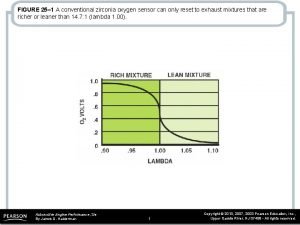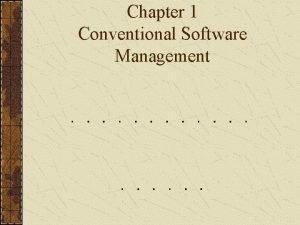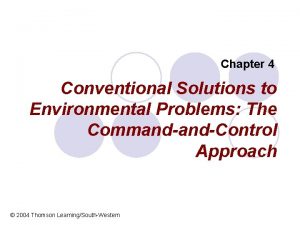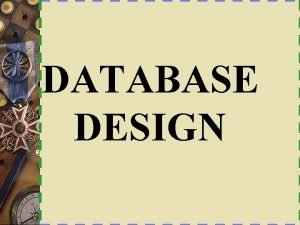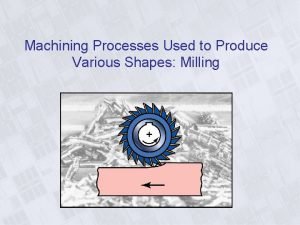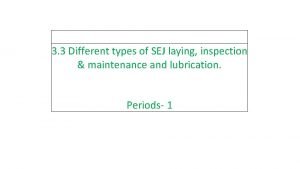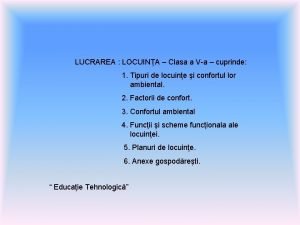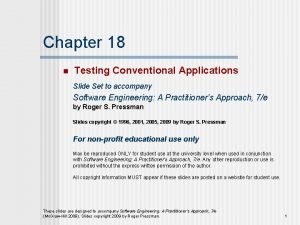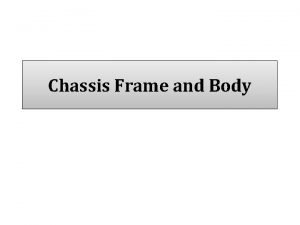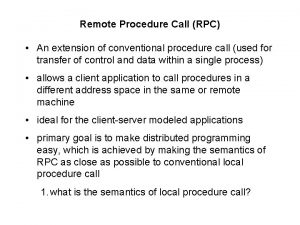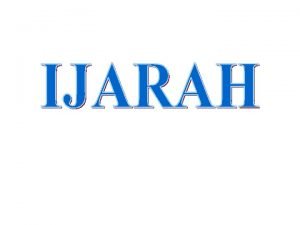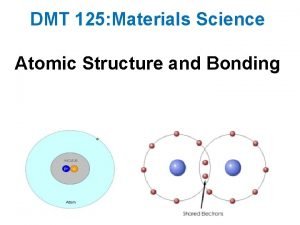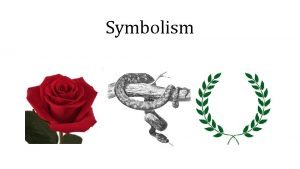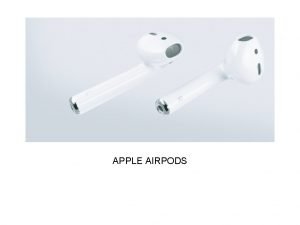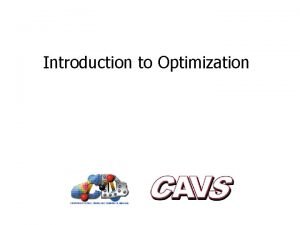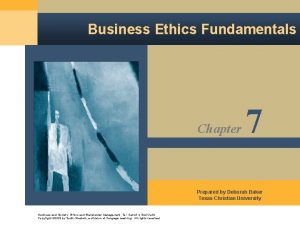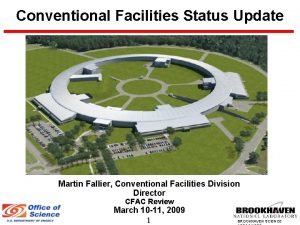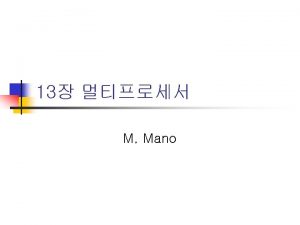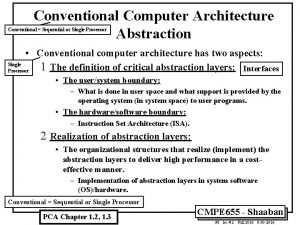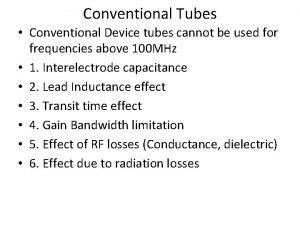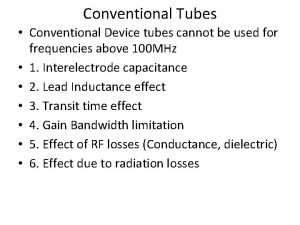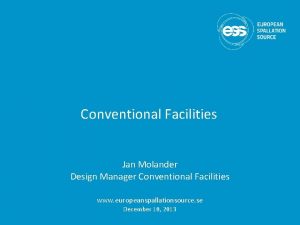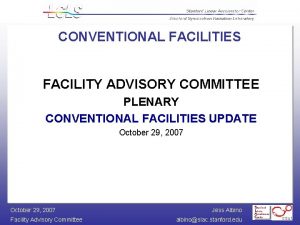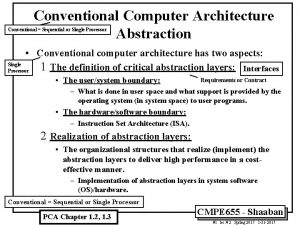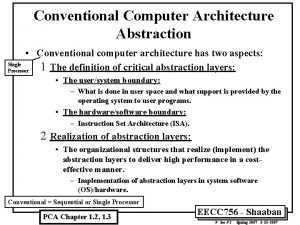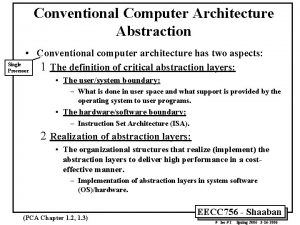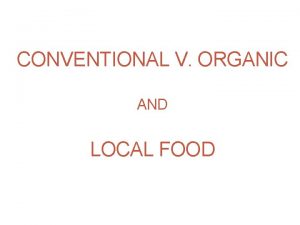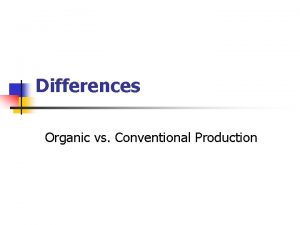Conventional Practices 1 Conventional Practices At times it































- Slides: 31

Conventional Practices 1

Conventional Practices At times it is necessary to depart from the exact rules of projections for the sake of increased clarity, or savings in drawing time and effort (without sacrificing clarity of communication). 2

Fillets and Rounds Exterior corners unsafe Exterior corner unpleasant Rounded external corner is called a round 3

Fillets and Rounds High cost of interior corners Weakness in interior corners Rounded internal corner is called a fillet 4

Fillets and Rounds are very common because of the requirements of manufacturing processes. It is very difficult to get sharp corners in components made by forging, casting, or bending of sheets. 5

This corner not rounded because the base of the bracket must be milled flat to sit on a mating surface Fillet . . Round 6

Rounded internal corners do not project properly 7

All rounded corners formed by unfinished surfaces are shown broken. 8

True projection Add line to show change of direction No line- poor practice From rounded corners 9

10

Conventional Practices: Run-outs 11

Run-outs Note: The Indian standards define this convention for the threaded hole 12

Run-outs 13

Conventional Practices: Run Outs for Intersecting Fillets and Rounds 14

Unnecessary details 15

Conventional Practices: 16

But do not conventionalize everywhere Difference between true and conventional is far too great 17

Unnecessary details 18

Conventional Practices: 19

But do not conventionalize everywhere Difference between true and conventional is far too great 20

But do not conventionalize everywhere Note: a small gap to denote that this edge is filleted! Difference between true and conventional is far too great 21

Conventional Practices: Treatment of Unimportant Intersections 22

Conventional Practices: Treatment of Unimportant Intersections Preferred Treatment 23

Conventional Practices: Treatment of Unimportant Intersections Preferred Treatment ETL 01 -VI- 24

Conventional Practices: Ribs 25

Conventional Practices: Ribs 26

Conventional Practices: Lugs 27

Conventional Practices: Lugs 28

Conventional Practices: Aligned features 29

Conventional Practices: Rotation of Features 30

Conventional Practices: Radial Holes 31
 Mat0022
Mat0022 Conventional oxygen sensor
Conventional oxygen sensor Conventional realistic investigative
Conventional realistic investigative Instrumental relativist orientation example
Instrumental relativist orientation example Late design breakage
Late design breakage Conventional solutions
Conventional solutions Examples of conventional crowds
Examples of conventional crowds Social conventional reasoning
Social conventional reasoning What is conventional encryption
What is conventional encryption Conventional databases
Conventional databases Trunked radio vs conventional radio
Trunked radio vs conventional radio Conventional journalism
Conventional journalism Shapes machining
Shapes machining Bottom up integration testing
Bottom up integration testing Conventional sej
Conventional sej Planul unei locuinte
Planul unei locuinte Test strategies for conventional software
Test strategies for conventional software Conventional pcr
Conventional pcr Full forward chassis
Full forward chassis Conventional encryption and message confidentiality
Conventional encryption and message confidentiality Remote procedure call diagram
Remote procedure call diagram Rules of ijarah
Rules of ijarah Computer architecture layers
Computer architecture layers Conventional spdf notation
Conventional spdf notation Conventional defintion
Conventional defintion Contoh penyelenggaraan makanan non komersial
Contoh penyelenggaraan makanan non komersial Magnetic levitation formula
Magnetic levitation formula Symbols for purpose
Symbols for purpose Digital fluoroscopy vs conventional fluoroscopy
Digital fluoroscopy vs conventional fluoroscopy Conventional earphones
Conventional earphones Conventional design
Conventional design Intentional amoral management model
Intentional amoral management model

